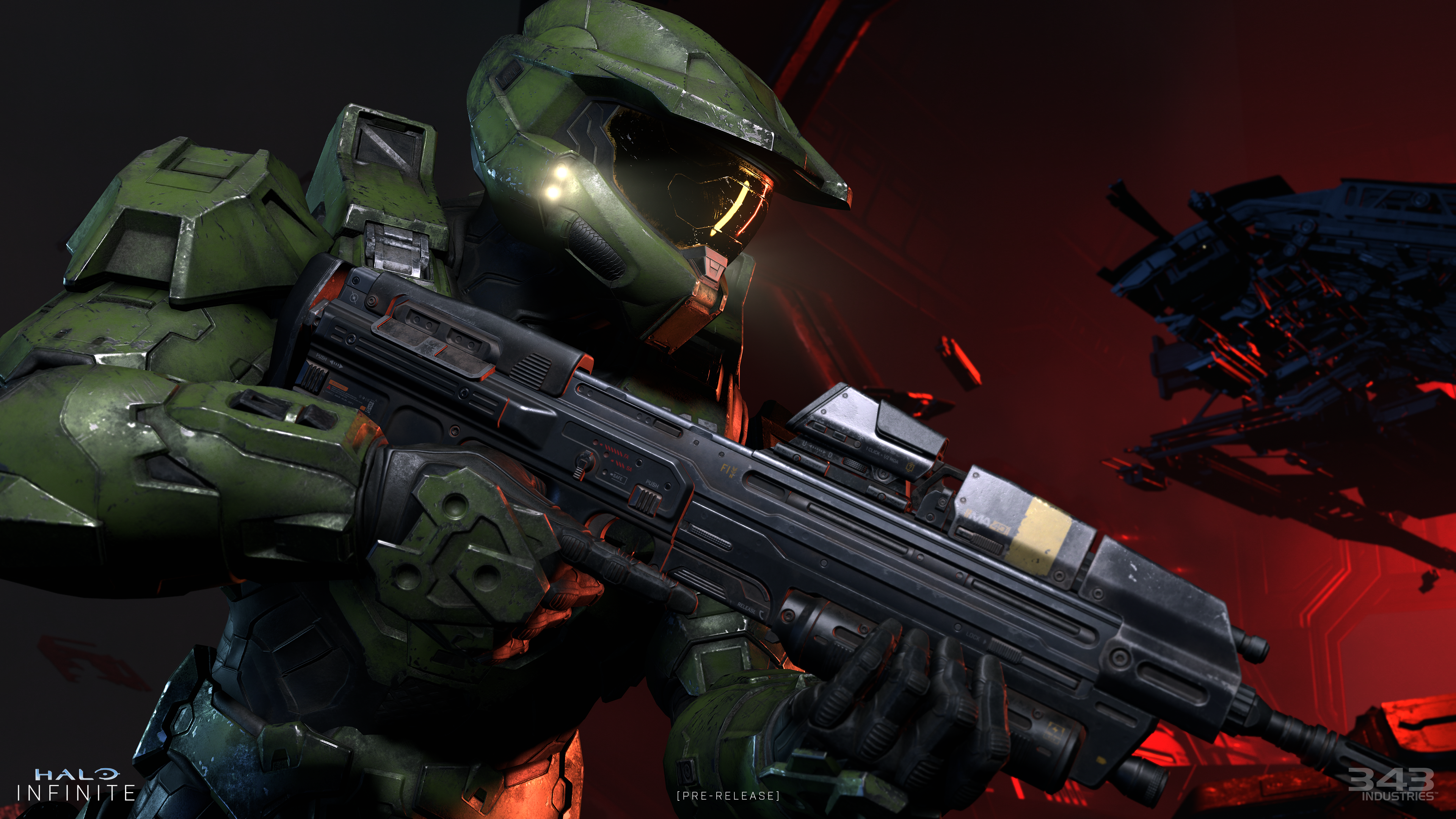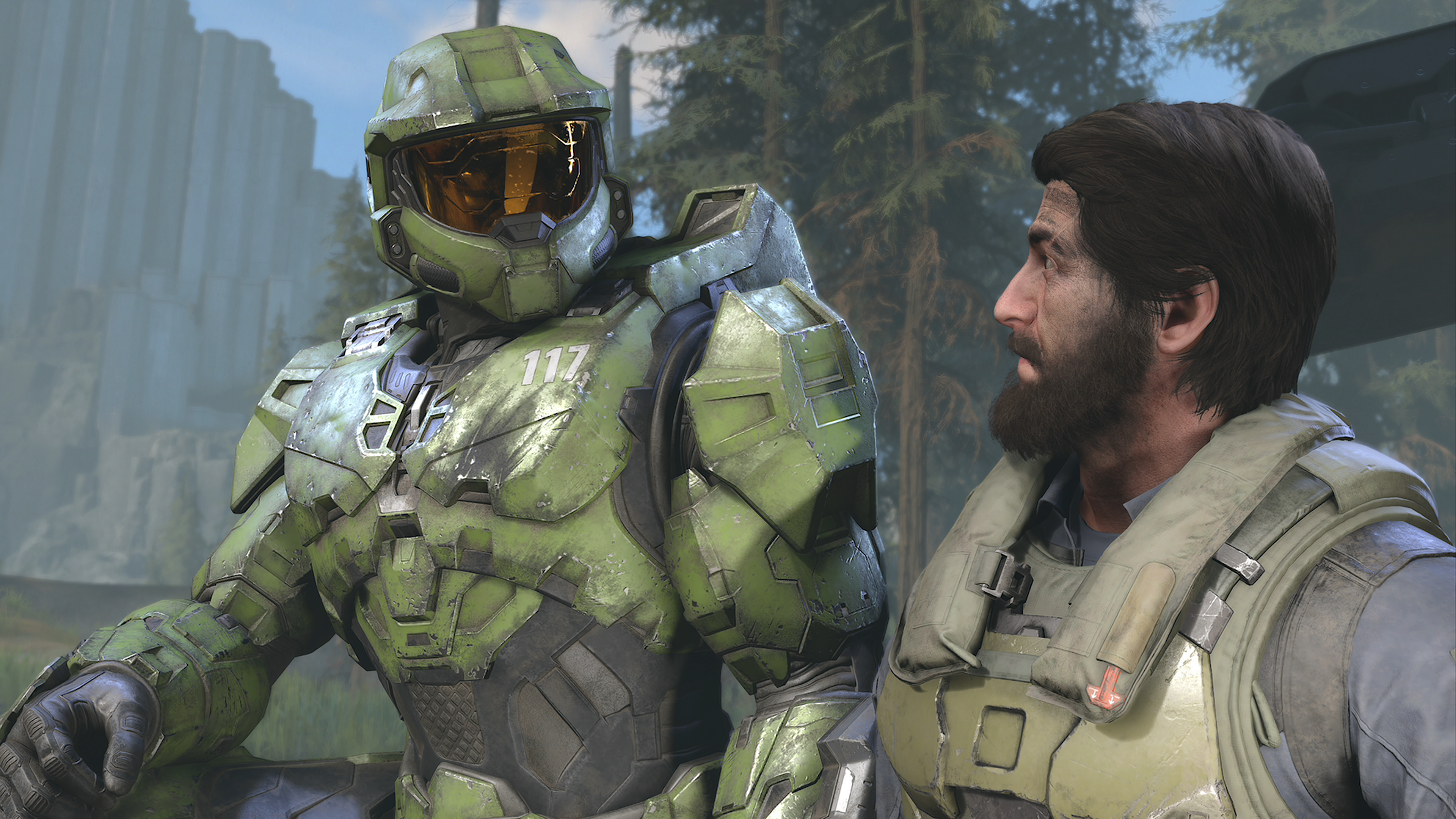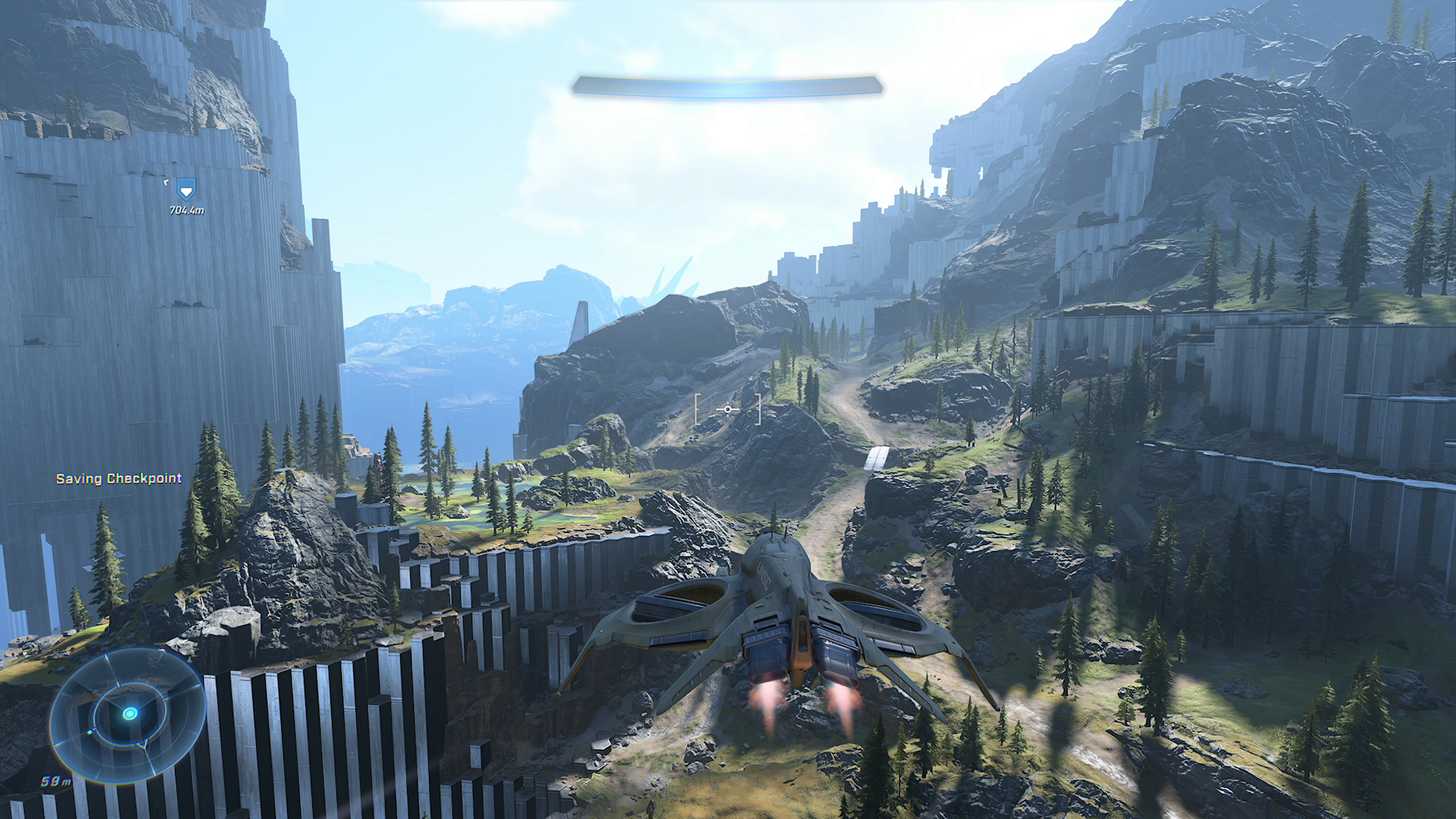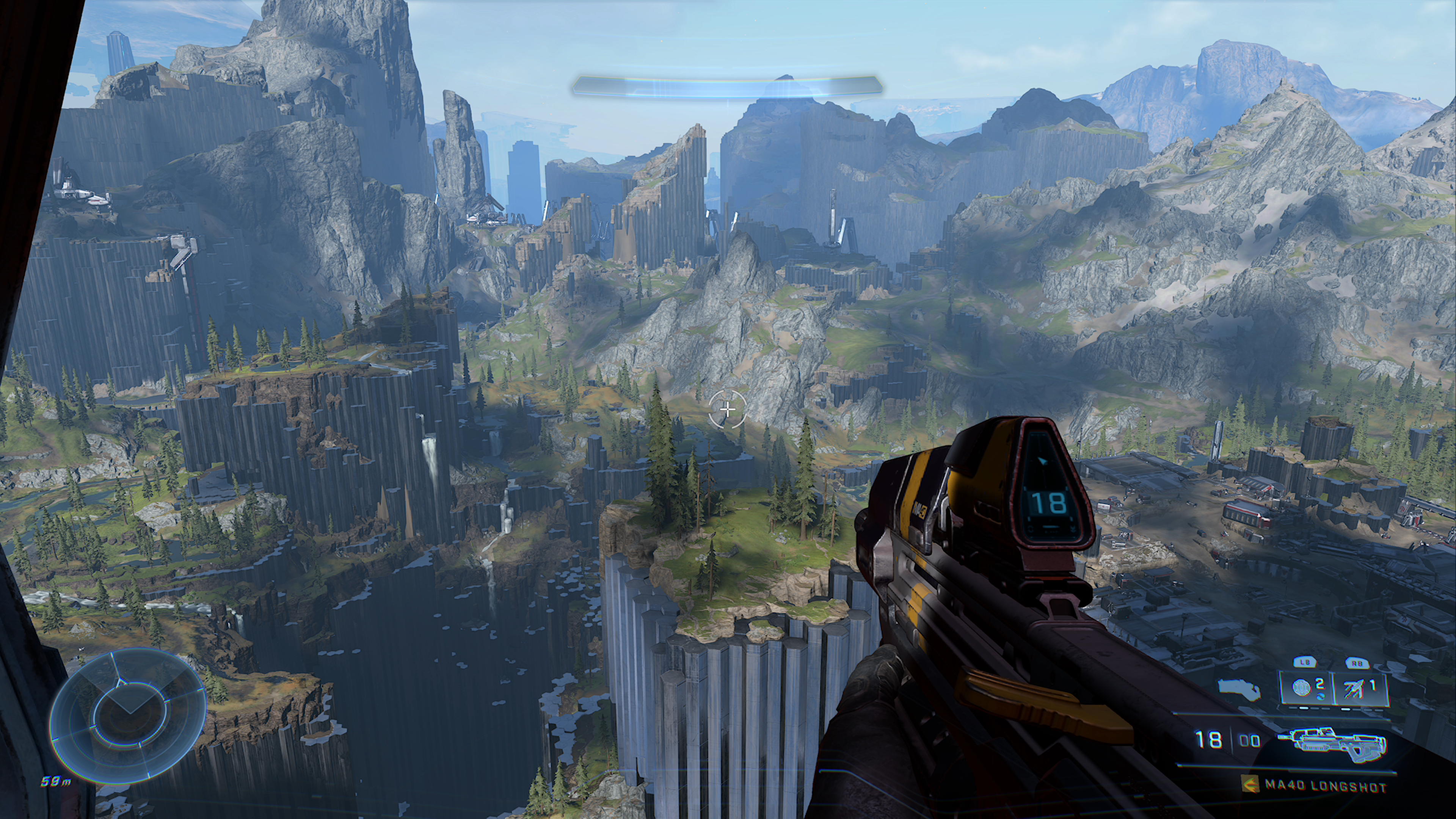That’s not a bad thing, however. Infinite feels like a coming-of-age for Halo studio 343 Industries, a developer created with the sole task of continuing the Master Chief’s adventures that has nevertheless struggled to step out of the shadow of Halo’s creators. Infinite feels like a resolutely introspective game, examining the Halo series at large and then working to reuse, reference, and refine every element that makes this franchise tick for a new generation. In many ways, it feels appropriately cyclical - the titular Halo is a ring, and the game at large works to bring the entire series full circle. That doesn’t just involve bringing it back to the original, but also includes touching base with everything that has come since. Halo Infinite’s open world, for instance, owes less to the slew of open world adventures on the market now and more to the original Halo’s most-beloved level, The Silent Cartographer. The fourth mission of the original game, it is the archetypal Halo experience. You start out on a beach, with a vehicle and Marine buddies. You use that vehicle to tear through semi-open environments before reaching an installation that you enter and explore. Firefights across open nature are instantly replaced by claustrophobic corridors. This is the structure of Halo Infinite - except a huge chunk of the game takes place within this framework, not just one level. In that sense, Halo 3: ODST also comes to mind. In that game, you’d explore an open world city at night, but then would be thrown into more traditional and linear campaign levels. There’s shades of ODST throughout Infinite’s campaign structure; it’s an open world where at certain points you’ll enter a building or the like that triggers a short loading screen that transitions you into a more typical A-to-B-to-C Halo story mission. The core story of Infinite unfolds across a series of stages undertaken in a set order, but non-linearity creeps in through the side activities and exploration you can undertake across the ring between the main campaign missions. These asides involve things like destroying the enemy’s installations, assassinating their leaders, and generally working to disrupt their operations across the Zeta Halo ring. It’s all combat-focused - this isn’t any other type of open world. The Chief can’t take his buddies bowling or race Warthogs across the map - but he can slay a slew of Banished forces in a variety of wonderful ways. It’s to the credit of Halo Infinite’s combat that this game delivers an open world where you do precisely one thing only and yet still has it land pitch-perfectly; I never got bored for even a second. I can’t quite describe how brilliant this combat feels. It’s not just same-old Halo, either; the new equipment options for Infinite, headed up by the grappleshot, open things up even further. The world itself does its bit here, too, as all the side activities take place on the Zeta Halo map. That means you can approach each encounter your way; you can go into an asssassination guns-blazing, you can snipe from afar, or you can try to cheese with a vehicle - or anything in between. The varied weapons and equipment - which benefits from the aggressive expansion of the Halo universe 343 has been steadily undertaking since Halo 4 - mean that every combat encounter feels a little bit different - even if you’re repeating the same thing. Story missions, meanwhile, are often a more traditional affair. Some of these take place in the open world, including one brilliant string where you need to take down a series of stations that are spread huge distances apart. But many of them are more typical Halo levels that you simply head to a location of the world to start. Some take you spelunking deep into buildings for contained, carefully-designed encounters. Others are wide-open matters spread across the open world, with how you travel between each objective left up to you. In terms of scale this is the biggest Halo yet, but in many ways the bombast of the story missions feels most specifically reminiscent of Halo 3, which I consider to be the high watermark of Halo campaigns. The end result is that there’s something here for everyone. If the non-linear elements don’t work for you, simply travelling straight next to the story waypoint will usher you from one level to the next - making for a decent facsimile of the structure of the old games. There will be some missions that are deliberately open-ended, but taken alone they don’t materially feel any different from the more free-form levels of past Halo games. Earlier on I suggested that Halo Infinite takes inspiration from practically the whole series, but I’ve only name-checked a couple of games - so let’s briefly touch on the rest. The way in which equipment settles into the rhythm of this game feels more like Reach. The way UNSC presence on the ring ramps up as you take over bases isn’t a direct reference but regardless echoes the grander scale of Halo Wars. Deceptively hefty in their influence are 343’s other two games, Halo 4 and 5. These games aren’t as massively beloved as the Bungie trilogy, but Infinite has given me a newfound appreciation for what 343 accomplished with them; Infinite has a wider variety of weapons, of enemies, of aesthetics - and a narrative with surprising impact. The joke is that Master Chief is a non-character, right? He kills aliens and doesnt afraid of anything. But… he’s really not just that any more, you know? He’s a character. He has relationships. Feelings. In Halo Infinite, he’s often quite funny, and even more often genuinely conflicted. This is largely accomplished through incredibly broad but surprisingly subtle body language, and great voice over performances from Steve Downes and Jen Taylor, the pair that is the heart of this franchise. What these two have accomplished with these roles is under-praised, I reckon: playing a machine and an emotion-blocking cog in the military machine, they nevertheless instill the series with a strong sense of humanity. The narrative is perhaps one of the most significant reasons to play Halo Infinite. After all, its core mechanics, excellent as they are, are available freely through the multiplayer modes. It was also one of the biggest surprises for me, as it’s effective and engaging. My interest in Halo lore has taken something of a nosedive in recent years - but Infinite drew me in early and kept my interest. Most interestingly, I think it’s a game that actually thematically has things to say. Buried beneath the explosive battles there’s a story about betrayal and learning to trust again. There’s also a story that likely resonates deeply with 343 Industries - about it being okay to leave elements of the past behind while also acknowledging that some parts of the past are too sacred to jettison. It’s in this way that I think Halo Infinite feels like 343 finally truly stepping into its role as the custodian of Halo with confidence; the game is great in its own right, but is also an effective mission statement, in terms of play and narrative alike, about the future of this series, Xbox’s flagship. So, all told, I’m gushing. There are elements that aren’t quite as praiseworthy, of course. Halo Infinite has proper boss fights - named enemies with health bars that must be gradually whittled down. These are extremely hit-or-miss. Some of these boss battles were genuinely thrilling, while others fell rather flat. Enemies that have been quietly hyped in the pre-release ultimately aren’t in the game that much, but each does get a memorable battle. Some are just memorable for the wrong reasons. As I prepare to jump into a Legendary difficulty run, I dread having to face off with a powerful Brute who spends half his battle in a relatively tight arena charging you with a Gravity Hammer. There’s also the visual stuff. My preview of the game upset some fans because I said Infinite “looked like a glorified Xbox One game.” Of course it does, some spat back: it is an Xbox One game. You’re right, of course. But the point is that there’s different sort of cross-generation games. Just look at Forza Horizon 5, a cross-gen game but also a wonderful Xbox Series X showcase. Halo Infinite isn’t really that. What you get on new machines is a higher resolution without a frame rate hit, rather than a visual showcase. With that said, Infinite does look especially nice during occasional moments - looking out over certain vistas from extreme distance, or when cutscenes ogle Master Chief’s armor in extreme close-up. And sometimes even that doesn’t work, where it sometimes feels distance detail is somewhat lacking across the Zeta Halo. Other times I wish they’d pull the camera back a bit, like in multiple scenes where a villain delivers monologues via hologram, where the tightness of the camera shot really exposes deficiencies in the model and animation. It’s all fine - I can’t stress that enough - but taken as a triple-A flagship game one does feel it’s potentially a little below what you might expect. Ultimately I can’t bring myself to care about that too much, though. Halo Infinite isn’t really all that focused on how it looks. 343 could certainly have made a visual powerhouse Halo, but it wouldn’t have been a game with the scope and ambition of this. Perhaps the polish in other areas, including the sublime balance of the combat, would’ve suffered. So I’m perfectly happy to take Infinite for what it is. Some of the clue of the nature of Infinite is in the name. This game’s final chapters are not yet written. There’s no co-op, of course, which is a major component of the Halo series. And much of this feels like a setup for an ongoing treadmill of content. There’s plenty of game here though - completing the story and getting around 60% overall completion took me around 15 hours - and as a foundation for future updates both single and multiplayer, they don’t come much better than this. Halo Infinite isn’t perfect. It has foibles and struggles here and there. But it’s also a slam dunk of a release; it’s exactly what Halo needs to be now. As Halo’s relevance has felt to wane over recent years, this is a bold statement that, no, Halo isn’t ‘over’. It was never close. It matters, and it’s still brilliant. I don’t mind waiting to see where updates take it, because what’s here at launch is already largely brilliant. I’m excited for the future of Halo again. Disclaimer: Tested on Xbox Series X and Series S. Game supplied by the publisher. Also available on Xbox One, Xbox One X, and PC.




